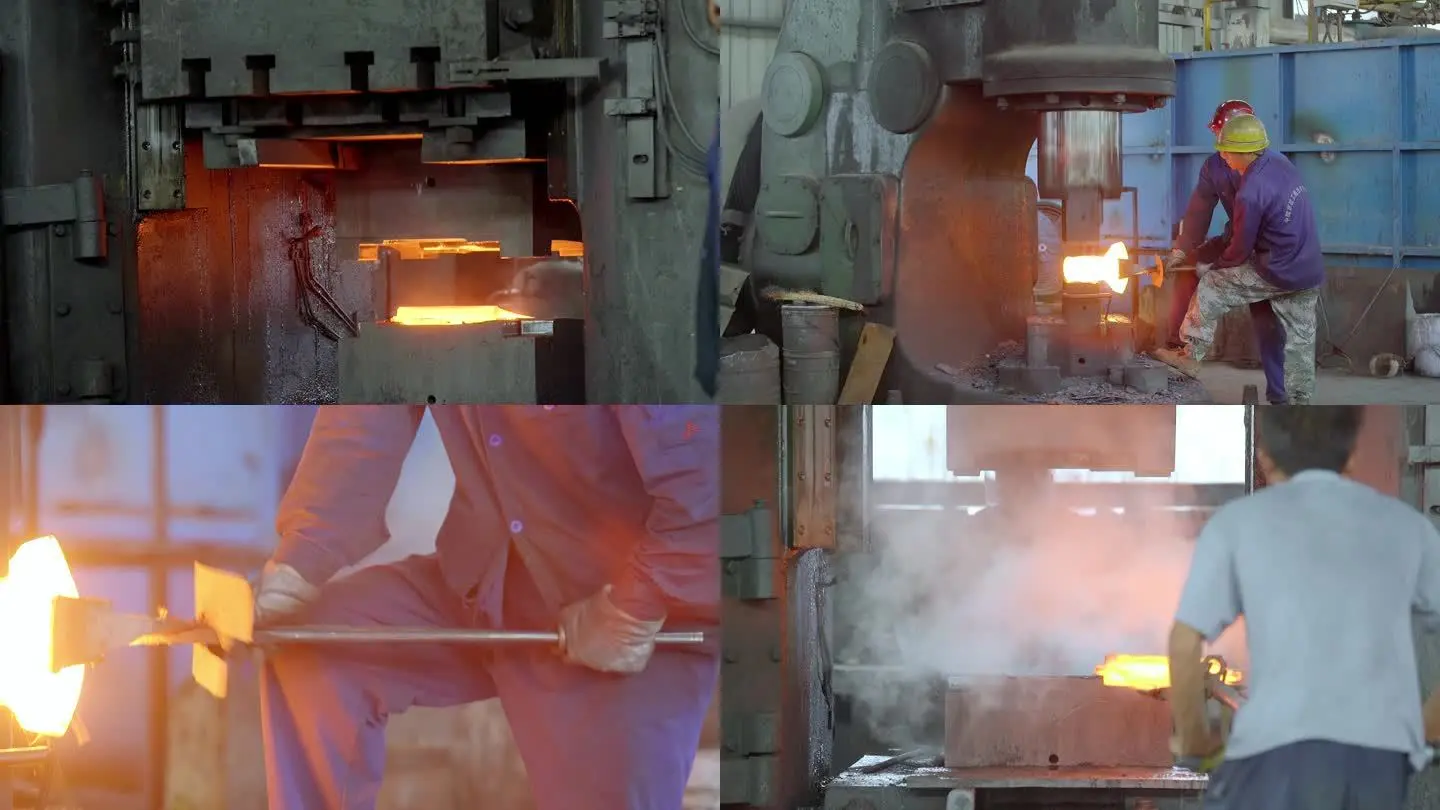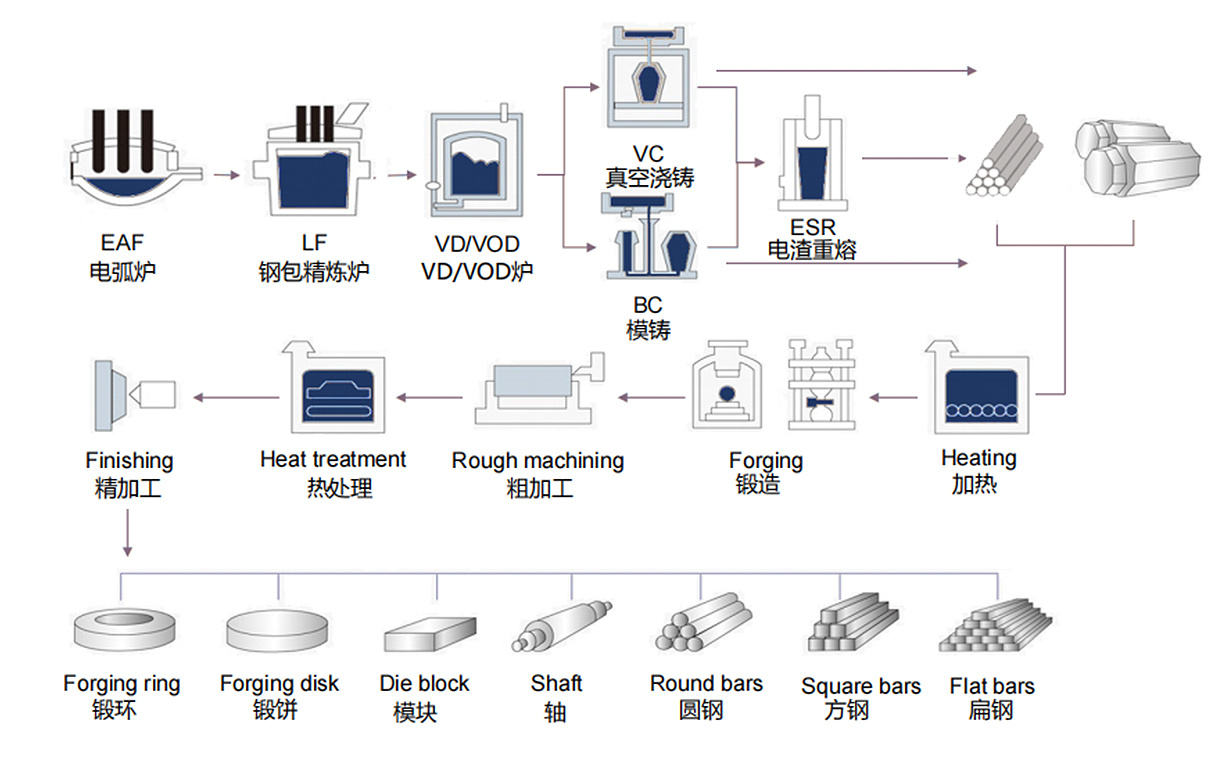La forja es un método de procesamiento que utiliza maquinaria de forja y estirado para aplicar presión a una pieza de metal en bruto, causando una deformación plástica para obtener una pieza forjada con ciertas propiedades mecánicas, forma y dimensiones. Es una de las dos partes principales del forja y estirado (forja y estampación). A través de la forja, se pueden eliminar defectos como la porosidad en estado fundido que se producen durante el proceso de fundición del metal, y optimizar la estructura microscópica. Además, debido a que se conserva el flujo de metal completo, las propiedades mecánicas de las piezas forjadas son generalmente superiores a las de las piezas fundidas del mismo material.
La temperatura de recristalización inicial del acero es aproximadamente de 727 °C, pero se suele utilizar 800 °C como límite de división. Cuando la temperatura es superior a 800 °C, se trata de forja caliente; cuando está entre 300 y 800 °C, se denomina forja templada o semi - forja caliente, y cuando se realiza la forja a temperatura ambiente, se llama forja fría. La mayoría de las piezas forjadas utilizadas en la industria son de forja caliente. La forja templada y la forja fría se utilizan principalmente en la forja de piezas de automóviles, maquinaria general, etc. La forja templada y la forja fría pueden ahorrar materiales de manera efectiva.
Según el mecanismo de conformación, la forja se puede clasificar en forja libre, forja en molde, rodado de anillos y forja especial.
Los materiales utilizados en la forja son principalmente aceros carbonados y aceros aloyados con diferentes composiciones, seguidos de aluminio, magnesio, cobre, titanio y sus aleaciones. El estado original de los materiales incluye barras, lingotes fundidos, polvos metálicos y metales líquidos.
En comparación con las piezas fundidas, el metal mejora su estructura y propiedades mecánicas después de ser procesado por forja. Después de la deformación térmica del proceso de forja en la estructura fundida, debido a la deformación y recristalización del metal, los grandes dendritas y los granos columnares originales se convierten en una estructura recristalizada equiaxial con granos más finos y uniformes. Los segregados, porosidades, burbujas y inclusiones originales en el lingote de acero se compactan y soldan, y su estructura se vuelve más densa, lo que mejora la plasticidad y las propiedades mecánicas del metal.
Las propiedades mecánicas de las piezas fundidas son inferiores a las de las piezas forjadas del mismo material. Además, el procesamiento por forja garantiza la continuidad de la estructura de fibras metálicas, haciendo que la estructura de fibras de la pieza forjada sea coherente con la forma de la pieza forjada y que el flujo de metal sea completo. Esto asegura que las piezas tengan buenas propiedades mecánicas y una larga vida útil. Las piezas forjadas producidas mediante procesos como forja en molde precisa, extrusión fría y extrusión templada son incomparables con las piezas fundidas.
Forging is a processing method that uses forging machinery to apply pressure to metal blanks to produce plastic deformation to obtain forgings with certain mechanical properties, certain shapes and sizes, and is one of the two major components of forging (forging and stamping). Through forging, the defects such as loose casting state generated by the metal in the smelting process can be eliminated, the microstructure structure can be optimized, and the mechanical properties of forgings are generally better than castings of the same material due to the preservation of complete metal streamlines.
The initial recrystallization temperature of steel is about 727 °C, but 800 °C is generally used as the dividing line, and hot forging is higher than 800 °C; Between 300~800 °C is called warm forging or semi-hot forging, and forging at room temperature is called cold forging. Forgings used in most industries are hot forging, warm forging and cold forging are mainly used for forging parts such as automobiles and general machinery, and warm forging and cold forging can effectively save materials.
According to the forming mechanism, forging can be divided into open forging, die forging, ring grinding, and special forging.
The forging materials are mainly carbon steel and alloy steel of various compositions, followed by aluminum, magnesium, copper, titanium, etc. and their alloys. The raw state of the material is bar, ingot, metal powder and liquid metal.
Compared with castings, the microstructure and mechanical properties of metals can be improved after forging. After the casting structure is deformed by hot processing by the forging method, due to the deformation and recrystallization of the metal, the original coarse dendrite and columnar grains become the equiaxed recrystallization structure with finer grains and uniform size, so that the original segregation, looseness, porosity, slag inclusion and other compaction and welding in the steel ingot, its structure becomes more compact, and the plasticity and mechanical properties of the metal are improved.
The mechanical properties of castings are lower than those of forgings of the same material. In addition, forging can ensure the continuity of the metal fiber structure, make the fiber structure of the forging consistent with the shape of the forging, and the metal streamline is complete, which can ensure that the parts have good mechanical properties and long service life, and the forgings produced by precision die forging, cold extrusion, warm extrusion and other processes are incomparable to castings.

